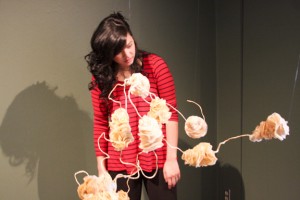
Soft olive hues within the gallery beckon visitors through the sheen of its glass doorway. A smooth manila carpet meets the gentle shading of the intriguing and fresh exhibit now at Ithaca College’s Handwerker Gallery: “reimagining the distaff toolkit,” curated by Rickie Solinger.
Each piece of art highlights a tool instrumental to women’s domestic labor from the 18th century through World War II. The exhibit, made up of loaned pieces by national artists, displays items such as pots, pans, baskets and rolling pins. The works focus on the concept of the “distaff,” a tool that holds unwoven fibers on a spinning wheel and keeps them from tangling.
Over time, the term distaff has become intrinsically linked with women’s labor and domesticity. The role of the distaff in this exhibit is to explore the social, cultural and historical implications of the labor facilitated by the displayed tools. The art acts as a form of social commentary, cross-culturally highlighting the concept of gender and labor throughout history and the significance of women’s unpaid labor. The artists featured in this exhibit seek to transform the debasement of the female experience and domesticity to something aesthetic that both honors the struggles of women and critiques their historical treatment.
The design of the exhibit is plain and streamlined. Upon first glance, it seems somewhat bare, but given a second inspection the viewer will easily see otherwise. The multimedia presentation makes the exhibit intriguing. Instead of featuring purely photographs or paintings, the artwork takes on the form of everyday domestic life items.
In this showcase, a series of dynamic pieces assail viewers, one of which is Tracy Krumm’s “Yoke/Folded.” A gleaming sheet of crocheted copper, which sits and swings upon a strong iron yoke hanging high from the ceiling, catches onlookers with each metallic glint. The peculiar setup of Flo Oy Wong’s “Ai Joong Wah: Great China” deserves considerable attention. An artistic layering of cooking utensils and snippets of worn photographs rests atop a metal baking sheet. Paired with the art is an aural medium of sound-bite recordings that tell the personal story of Wong’s family life. The sequence concludes with poetry readings in both English and Chinese, the artist’s two spoken languages.
On the far wall of the gallery sits Tatana Kellner’s “Ironing,” the most dynamic piece in the exhibit. A series of tightly pressed white T-shirts, which are spread taut along the gallery’s wall, hang crisp in the gallery light. Each shirt bears a screen printed image depicting different types of irons used throughout history. Below each shirt, which hangs like a distant and understated flag at half-mast, lies a brief commentary on female domesticity and labor.
At the base of the T-shirt display sits along narrow board bearing the weight of a small, sturdy iron. Every few minutes, in an almost startling fashion, the iron lets out a gurgling burst of smoke and, as if handled by an invisible man, begins to iron the single shirt laid across the ironing table. Each faint puff of smoke is ominous but mesmerizing, thickly clinging to the air.
Dave Cole’s “Trophy Wife No 3 of 8” depicts the compressed bodice of a female mannequin whose headless body is complete with a thick abrasive set of antlers. The startling juxtaposition between a trophy wife and a hunting token denoted from the antler display is bizarrely stunning.
This exhibit confronts truly hard-hitting issues. But in the sweet lighting, surrounded by these everyday items, exists a pathway to history. In these works of art observers learn to appreciate the universal struggles of domesticity and gender.
This exhibit is surprisingly beautiful and shockingly thought provoking.
“reimagining the distaff toolkit” is on display until March 6 at the Handwerker Gallery and culminates with a symposium on March 3 at 5:00 p.m.




